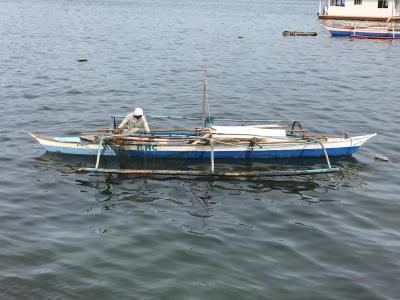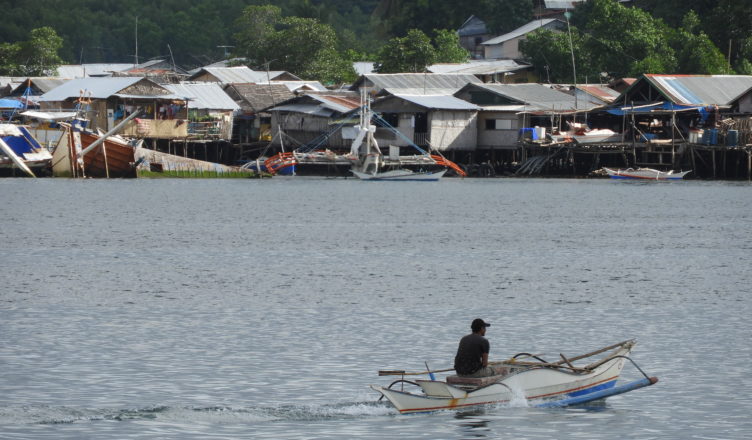Today’s blog is short on the normal array of pictures for such a visually interesting destination as we’ve experienced the last week and a half. The reason is that Internet service has been such that the approximately 1,000 pictures we’ve taken are stuck on our local devices, unable to sync to Dropbox on the Internet-over-hemp-vine service we are enjoying here on the island of Palawan in the Philippines. Dodgy Internet service, however, goes hand-in-hand with visually interesting destinations, so you will simply have to rely more than usual on my stunning wit to spark your imagination.
Palawan is an island in the Western Philippines, a nearly 300 mile long finger stretching south and west of the rest of the Philippines, pointing accusingly at the island of Borneo just to the south. When researching top destinations in the Philippines, Palawan is certain to be on your list. There are two likely spots on Palawan you’ll consider: the middle part of the island, where you’ll find Puerto Princesa, the island’s capital, and the very northern tip where you’ll find the town of El Nido and, just off the coast, the islands of Coron.
We’ve been staying in the town of Puerto Princesa (sometimes called just plain “Puerto”) for the past week and a half and will be here a total of two weeks when we fly back to Manila on Wednesday. Even staying two weeks, we preferred to stay put, assuming we’d return one day and next time we’ll try the northern sites of the island. No place has tested our travel standards more than Puerto Princesa, which is to say this is as under-developed and third-world as we’ve stayed since our full time travels began June, 2014. Except perhaps New Jersey.
We’ve commented many times before that English is (perhaps a bit sadly for us white people of Anglo-Saxon descent seeking travel adventure) spoken pervasively around the world. Not so much here in Puerto. Hotel workers, by necessity, will speak English, but venture into some off-main-street restaurants and food stands and there you’ll find there is one family member of the establishment, usually a younger person, that will be flagged over to take your order. Consider this recent exchange we had in a Palawan restaurant:
Chuck: This menu is in a foreign language: the characters are strangely familiar, but I can’t quite make it out.
Lori: You’re holding it upside down.
Chuck: Oh.
Still, I felt it safest to order by pointing at the pictures. Do not ridicule me: I got the little pork skewers I wanted, and I daresay you, dear reader, might have gotten something quite different.
Flying to Palawan is relatively easy, especially Puerto. The town surrounds and hugs the Puerto Princesa airport (airport code PPS), in such closeness that we’ve enjoyed sitting on the balcony of our hotel and getting bathed in jet wash as landing jets pass stone-tossing heights overhead. There are regular flights within the Philippines from Manila and the resort islands of Cebu and Panay, and there are weekly international flights from Taipei, Taiwan. If El Nido is your Palawan destination choice, your flights will be limited to Manila and Cebu. Once to either location, understand that to get to the other (Puerto Princesa to El Nido or vice versa) will involve a six-hour trek on a mule. Not really, but a six-hour Palawan bus ride might leave you feeling like you’ve been on a mule as long.
Don’t expect four and five-star resort options in and around Puerto. The biggest idea of a beach resort is a Microtel (that’s right, the cheap roadside motel by US standards). You’re better off considering a locally-owned place, like the Puerto Pension where we’ve stayed. For less than $40 a night we’ve enjoyed smiling Filipino service, a continental breakfast every day (that actually includes eggs) served from a rooftop restaurant with great views of the bay, a wonderfully comfortable bed (in a rather snug and compact room), and the wonderfully tropical décor of an “eco-resort”.
( Imagine the picture of a lovely little hotel with hammocks, lots of bamboo, teak wood, and wicker here. )
Getting around town is a fun enough experience to warrant coming here. Seriously. Just land at the airport and ride the “trykes” around randomly for a few days, then leave. The “trykes” are motorcycles with sidecars built around them, complete with overhead cover, front and rear windshield for you and the driver, and room for two (or ten, if you’re a Filipino). Don’t worry about having trouble hailing them: just set off down any street or dirt path and six will pass you and offer a ride before you’ve taken three steps. You can hardly turn around without running into one or two of them. There might actually be more trykes than Filipinos in Puerto (and there are a lot of Filipinos here).
( Imagine a picture of Rizal Avenue, Puerto’s main street, jam-packed with thousands of trykes. )
A tryke ride from the airport to the center of Puerto Princesa might cost you 20 pesos (about 40 US cents). Or maybe it’ll cost you 40 pesos. Or you might be offered to pay whatever you like (seriously, but just don’t be a cheapskate).
There are a couple of must-sees when in Puerto, all of which are accomplished through a tour, which your hotel mostly likely can arrange. The first and foremost, and one of the principle sites currently attracting tourists to central Palawan, is the underground river. This Filipino National Park is about a two-hour ride from Puerto Princesa, so unless you want to be bounced around for a few hours in a tryke that might cost you $10 (or $1,000—who knows?), be sure to arrange a tour. Access to the subterranean river is limited on a daily basis, so you’ll probably have to wait around on the dock until time to board a boat (an interesting part of your day) for a 15km ride to the entrance to the park. Keep an eye out for macaque monkeys eager to steal your stuff and do Groucho Marx impersonations for spare change. Then board your boat and pay careful attention to the audio tour (the ride through the caves are silent so as not to disturb the bats—oh, and don’t look up with your mouth open).
Another must-see tour is the Honda Bay tour. Just north of the city is a dent in the eastern coast of Palawan called Honda Bay. Within the bay are a number of sandy-beached islands that are the best, most convenient, place near Puerto to get some sun and do some snorkeling. Our tour took us to Starfish Island, appropriately named for the multitude of chocolate chip starfish we found at the very end of the island. These orange and brown thick-legged starfish creep along in the clear, shallow waters by the hundreds. There’s also an area set aside for snorkeling: the coral isn’t much to look at, but there are fish and sponges in abundance.
Our tour also took us to Lilu Island, a sandy spit surrounded by mangroves that was mostly good for swimming and sunning. And our final Honda Bay island hop was Cowrie Island, the most developed of the islands we saw, with restaurants, a couple of beach bars, and extra-cost beach activities such as being dragged behind a jet ski on an inflatable raft at speeds that achieve lift above the water, or being dragged around on a giant inflatable hot dog. We’re contemplating going back to Cowrie Island before we leave next week: we didn’t get to ride the hot dog last time.
The third tour we took is known as the Firefly Dinner Cruise. This little evening boat ride, leaving Puerto’s Baywalk water front pier, takes you across the bay to the interior of the island where you transfer to a flat-bottomed boat for a 7:30pm rendezvous with some of Palawan’s more interesting bugs: fireflies. Now we southerners take fireflies (aka “lightning bugs”) a little for granted and forget that many people—such as a Norwegian we met staying at our hotel—have never seen one. Even though we’ve seen plenty of these cool little bugs (more in our younger days), it was still pretty cool to see the concentration of them along that never-before-developed stretch of Palawan river. The fireflies favor certain trees and congregate in single trees by the hundreds, perhaps thousands, such that as you float along you suddenly come along a tree that looks as though it’s been decorated for Christmas. We learned that they react to red light by shining more brightly, a nifty trick employed by our tour guide to get the fireflies to flare up at us. Note to self: hours of summer evening fun in the South can be had with nothing more than a red light.
( Imagine a stunning night-time picture of a tree with thousands of tiny pinpoints of light. )
There is one other tour that would have been available to us had we been here in the right season: a whale-watching tour. Unfortunately for us, it’s just not the season for whales to be migrating past Palawan. Next time, maybe.
A few final notes on cuisine. Most restaurants serve something picky westerners would eat: pasta, pizza, steak, burgers, etc. But the local fare here is Asian tropical. Expect rice with every meal, especially the signature Filipino garlic rice, or a “dirty rice” with veggies and bits of pork or ham. Barbecued chunks of pork or chicken on little wooden skewers are pretty much a can’t-go-wrong choice. There are full service restaurants in the main part of town, as well as gut-challenging food stands and stalls in between and on side streets. Seafood is common, from shrimp and crabs to various white fish and oily mackerel-like fish. All the seafood we’ve had has been great, a solid testimony considering we grew up on seafood. Along Puerto’s Baywalk you’ll find a dozen or so restaurants serving local fare. Often meals for two are enjoyed for the equivalent of about $10. A meal of $20 for two is a splurge.
A few of our favorite restaurant finds: Neva’s Place (great little brick-oven pizzeria in a cool tropical setting), K’na Boyet Grill and Restaurant (fantastic grilled seafood—pick out what you want and tell them how you want it prepared—with two locations at the Baywalk), Balinsasayaw Restaurant (you can’t go wrong with the BBQ pork skewers, and don’t miss the coco noodles), and Kinabuch’s Grill and Bar (a mix of Filipino and bar fare).







